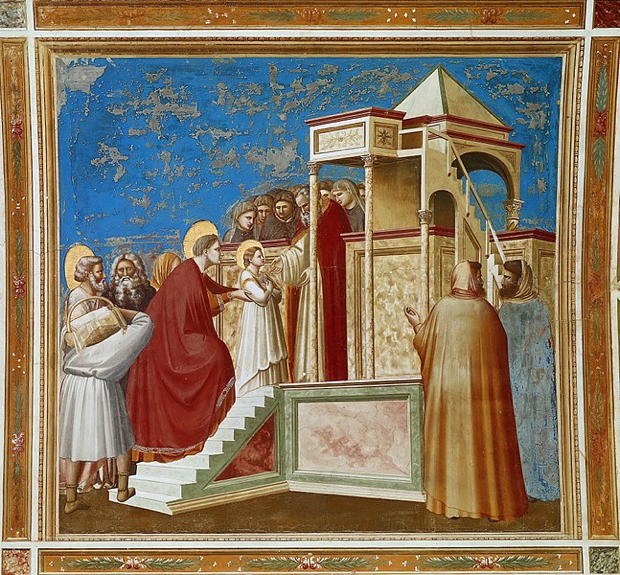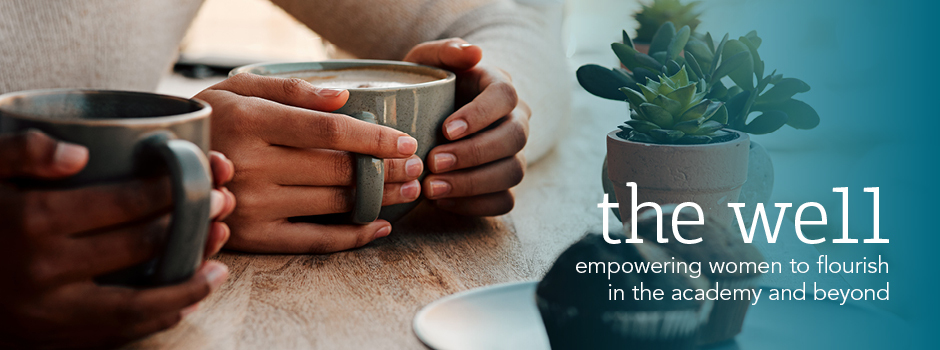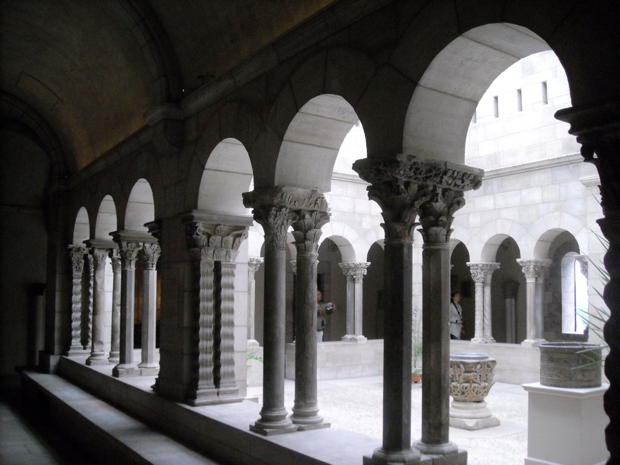Saint-Guilhem Cloisters.
How did you become an art historian?
I grew up in Oklahoma. In my family, no one really knew what art history was, and it was not offered as a course at my high school, but I had a fascination with things that were old. Looking back, I think there were two things that really had an impact. First, there was a little museum in the town where I lived that had a few Egyptian objects, and my best friend's mom was a docent there. Second, I had a really great AP American history teacher, and we went to Washington, DC and visited museums. I didn't have a lot of exposure to art or art history until I went to college but I had this feeling that I liked objects and I liked history.
I went to college at William Jewell, near Kansas City. My academic advisor put me in an art history class to get a requirement out of the way. I was a history major. There was no art history major, but the artist who taught the class was fantastic. I fell in love with it.
I was always looking to get away from Oklahoma, so I was always trying to find something to do during the summer to get out of going home. I spent my junior year at Oxford, but freshman or sophomore year I was in the study commons and there was an internship book on the table. I saw an internship at The Cloisters listed. I had done a report on The Cloisters — as in, I watched the VHS video from the library and wrote a report on it for my art history class. It seemed like such a cool place and I applied for the internship. I can only explain that it was God, because there were like 250 applicants and 8 interns selected. I was the only applicant they picked from between the coasts. Going to the interview was my first trip to New York. Spending that summer in New York was my first time being on my own in a non-college environment. It was really life-changing. There is no better place to fall in love with medieval art than The Cloisters. That summer I really figured out that I wanted to do this for the rest of my life.
The Institute of Fine Arts, the NYU art history school, is across the street from The Met. The summer of my internship we had gone to The Met for a visit and the director just walked us across the street to look at it. It's in this old mansion right on 5th Avenue. We walked in and I was like, “wow, this is cool.” I wouldn't have had NYU or the IFA on my radar without that internship. That summer I realized how much I really loved New York and that it was clearly the center of the art world in the states. I applied to grad school my senior year of college and went to NYU the fall after I graduated.
My initial goal was to be a curator. I worked at The Cloisters as a lecturer through grad school and I had a predoctoral fellowship at the Frick Collection in Manhattan for two years as I was finishing school. I went to work for The Museum of Biblical Art, which no longer exists. It started as an art gallery in the American Bible Society and existed for about ten years. It was a really hard job but a great learning experience. It was my first real job that wasn't part-time or an internship or fellowship, but actually being a curator.
I kept that job for two years. But I love doing research. I love being able to travel and not having to park myself in an office all day, so I did the pivot to academia. I had continued adjunct teaching on the side to keep my resume ready for an academic job. I worked on getting my book published. In my second year of applying for jobs, I got two job offers and one of them was here at Tulane.
What drew you to medieval art and artists?
I don't think I would have had the same connection if I had not been Christian. I don't know if I would have been as interested in the stories of Christ and the apostles or Mary had I not grown up in the church and known the stories. I know plenty of art historians, even medievalists, who grew up secular or Jewish, but somehow the stories resonated with me. Having grown up seeing stained glass — even though it was contemporary — in my church made a difference. Even though I don't find myself worshiping in front of art in a direct way, I think choosing to be a medievalist had something to do with my Christian upbringing.
In what ways has your study in art history impacted your spiritual journey?
I grew up Baptist, but it wasn’t a totally iconoclastic situation. My youth minister was an artist at Oklahoma Baptist University, which was across the street from our church. When I was in high school, they renovated our church and put in stained glass designed by this woman.
If you’re a Baptist, you don’t really grow up looking at images. I wouldn’t say I use images as a worship practice now, but I think that learning about the history of Christianity generally and legends has influenced my faith. My research is on extrications and embellishments of biblical stories — the way that writers in the later Middle Ages were trying to find new material to give people more to meditate on. I’m still Protestant, not focused on images in worship, but have a different understanding. I’m more open to different traditions and understanding more about what’s real and not real. I recently went to Jerusalem for the first time, and I was surprised that I was not as moved. I was seeing how the spaces were really fraught and contested. The historian in me struggles a little bit. Sometimes I think I'm more of a skeptic now.
We hear often about humanities departments getting removed or slimmed down significantly. What do see as the value of the humanities, and art history specifically, in higher education?
It’s a dangerous trend. Part of the problem is that smaller schools that are expensive are asking the question, “How can someone use the discipline to get a job?" The misguided part is that what an undergraduate earns doesn’t have to correlate directly — and most of the time doesn’t correlate at all — with their future career. This is a myth that persists. I was on a panel for admissions and a parent asked, “What’s the value for my money?”
What people need to realize is that art and art history teach you skills that you will not learn in the "real world." You can become articulate about culture, humanity, and life. You learn to write, to express yourself creatively; you learn visual thinking skills. You learn how to critically analyze an image, not just take it for face value. You are learning skills that make you a decent human and give you the tools and path to any career. Students might think, “I need to do marketing.” If you get a job in a firm, the marketing job will teach you how to do marketing. Skills are developed. If you know something about art, you're going to be able to talk to your boss about their trip to Europe. You’ll know how to enjoy yourself at a museum. You're going to be able to write clearly. People need to focus more on the skills that are developed in these disciplines as opposed to the outcome.

"Presentation of Mary at the Temple" — one of the frescoes by Giotto at the Arena Chapel in Padua.
If you could travel anywhere to see a piece of art in real life, where would you go and what would you see?
I’m very lucky because I get to travel to Italy all the time. If I were to choose places I have been and would go back to, I'd say the Arena Chapel in Padua to see the beautiful frescoes by Giotto. In Florence, I love the Church of San Marco with frescoes Fra Angelico painted in the individual friars’ cells.
I still have a lot of places on my bucket list: at the top are Machu Picchu and Egypt.
What advice do you have for people as they go to an art museum? The experience can sometimes be overwhelming. Do you have any advice specifically for a Christian visiting an art museum?
I would say the first rule of thumb for anybody going to an art museum is don’t try to do too much. Don’t do the Met in one day. Choose a topic or a theme. Go to the Asian wing. Spend an hour. Don’t overdo it. Everyone gets museum fatigue, even me. For everyone it’s different.
You have to explore a little bit, see what moves you. Is it color? Is it abstraction? Is it stories or narrative? I have abstract art hanging in my house, but if I'm looking at museums or doing research, what I do is around narrative art — stories and storytelling. It depends on your goal. Is it a worshipful experience? Is it to learn something? What’s your goal?
Looking at renaissance painting of Christ or the madonna doesn’t trigger a prayer response in me, but I’m more interested in those narratives because of my faith. For some Christians, a Rothko is going to mean more to you than an image of Christ on the cross.
As a Christian, a museum shouldn’t be a replacement for church. I think art can speak to you spiritually. What’s the purpose of the museum? Museums are more often being created as entertainment, but previously they were ways of educating the masses, or ways to preserve art, or collectively study art. As the world has gotten more secular, there's more of a tendency to say, “I'm going to go worship at the museum.” I'm a little bothered by the idea of a museum being a replacement for church, but you can have a spiritual experience there, just like you can anywhere God has created something beautiful or interesting or moving.






